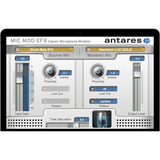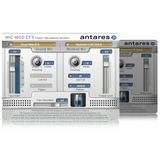Antares Mic-Mod EFX Microphone Modeling Software || Your Software Registration Code and Instructions Will Be Sent to You, Along With an URL Connecting You Directly to The Manufacturer, Who Will Provide You With Your Software. We are Authorized Antares Resellers. Verify Our Credentials on the Xchange Market. Please Be Aware That Software Is Non-Cancelable and Non-Returnable. If you have any questions about this product please do not hesitate to contact us.
Mic Mod EFX - Classic Microphone Modeler - Now the mics you own can sound like the mics you wish you owned.
Mic Mod EFX is the microphone-modeling tool that makes the microphones you own sound like the microphones you wish you owned. Spice up your tracks with models of vintage mics from Neumann, Coles and others plus modern boutique microphones. Our patented Spectral Shaping Tool™ technology gives you precise digital models of over 100 legendary microphones. Simply tell Mic Mod EFX what microphone you are actually using and what microphone you’d like it to sound like.
Not only do Mic Mod EFX’s models reproduce all of the subtle sonic characteristics that make each microphone unique, but they also give you control of each mic’s specific options. Does the mic have a low cut filter? If so, it’s in the model. Wind screen on or off? Close or far placement? Each option results in the same sonic effect that it would have with the actual mic. For that final touch of perfection, you can even add some tasty tube saturation. Mic Mod EFX gives you a huge virtual microphone collection that you can use for recording, mixing and even in live performance to get the sound of mics you would never consider using on stage. It’s also a great tool for broadcast and podcasting applications.
If you’ve ever wished for an extensive collection of exotic mics (but shuddered at the cost), then Mic Mod EFX is the plug-in for you. Not only do Mic Mod EFX’s models reproduce all of the subtle sonic characteristics that make each microphone unique, but they also give you control of each mic’s specific options. Does the mic have a low cut filter? If so, it’s in the model. Wind screen on or off? Close or far placement? Each option results in the same sonic effect that it would have with the actual modeled mic. And for that final touch of perfection, you can even add some tasty tube saturation.
Source Mic and Modeled Mic - Simply select the mic you’re using (or used during your original recording) and the mic you want it to sound like.
Proximity - Proximity Effect is a bass boost that results from placing a directional mic in close proximity to a signal source (e.g., a singer’s lips). With Mic Mod EFX’s Proximity controls, you can actually create the effects of different mic distances based on the specific physical properties of each individual modeled mic.
Low Cut Filter - If your source mic has a low cut filter, enter its setting in the Source Mic Low Cut menu. If your selected modeled mic has a low cut filter, you can model the effects of any of its settings with the Modeled Mic Low Cut menu.
Pickup Pattern - If your source mic has variable pickup patterns, enter the selected pattern in the Source Mic Pattern menu. If your selected modeled mic has variable pickup patterns, you can experiment with the effects of any of its patterns with the Modeled Mic Pattern menu.
Tube Saturation - Based on the same technology as Antares’ famed WARM Tube Saturation Generator, the Tube Saturation control lets you give your track the warmth of a high-quality tube pre-amp.
Microphone Models - The following microphone models are included with Mic Mod EFX.
- AEA R44C
-
AKG C12A; C414; C414B/ULS Limited Edition Gold; C414B/ULS Modified by Audio Upgrades;
460B/CK61-ULS; D112; C1000S; D790; C3000; C4000B; C 12 VR; C414 EB; C535 EB; The
Tube; D1; Solidtube; D5; Perception 120; Perception 220 - Alesis AM61
-
Audio-Technica ATM11; AMT25; ATM31; AT813A; AT853Rx; AT3525; AT4047/SV;
AT4033a/SM; AT4050; AT4055; AT4060; AT4051; AT2020; - Audix D4; OM2; OM3-xb; OM5; SCX1; CX111; OM-6; D-1; SCX-one
- B&K 4007
- Behringer Ultravoice ECM 8000; Ultravoice XM8500
- Beyerdynamic M-500; M-500 Limited Edition Classic; MC-834; CK-703
- Blue Bluebird; Blueberry; Mouse; The Bottle
- Brauner VM1; Valvet
- CAD Equitek E100; Equitek E200; Equitek E350; C400s; VSM1; 95Ni
- Coles 4038
- Earthworks Z30x; TC30K; QTC1
- ElectroVoice N/D357; PL20 RE55; RE15; N/D868; N/D767A
- Groove Tubes MD-1
- Langevin CR-3A
- Lawson L47MP
- Manley Labs Reference Gold
- Marshall MXL 2001P; MXL 2003
- MicroTech Gefell UM 800
- Neumann U47; U 87; U 87 70th Anniversary Gold Edition; M 149; TLM 193; KM 184; TLM103; U 89i
- Oktava MC-012; MK-219; MK-319
- RCA BK5A
- Rode NT1; NT2; NTV
- Royer R-121
- Sennheiser MD421; MD441; E609; E835S; K6-ME64
- Shure Beta 52; Beta 57A; Beta 58; Beta 87A; Beta 98D/S; SM7A; SM57; SM58; SM81; SM98A; KSM32; VP88
- Sony C37P; C48; C800G
- Soundelux U95S
- Tannoy Large Vintage Ribbon; Small Vintage Ribbon
- Telefunken U-47 (Original Tube)
All trademarks are the property of their respective owners. The manufacturer names and model designations are used solely to identify the microphones analyzed in the development of our digital models and do not in any way imply any association with or endorsement by any of the named manufacturers. This product is not guaranteed to produce, and will not necessarily produce, audio results that are consistent with or match audio results that could be achieved using any of the referenced microphone models.



